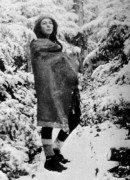 Over the holidays, I found two fascinating pieces about women who wrote in the first half of the 20th century. The more haunting one — written by Paul Collins for Lapham’s Quarterly — is about Barbara Newhall Follett (at left), who started writing her first novel at the age of eight, sometimes putting down 4,000 words a day:
Over the holidays, I found two fascinating pieces about women who wrote in the first half of the 20th century. The more haunting one — written by Paul Collins for Lapham’s Quarterly — is about Barbara Newhall Follett (at left), who started writing her first novel at the age of eight, sometimes putting down 4,000 words a day:
While her notes to her playmates and family overflowed with warmth, she was absolute in guarding her time to write. Neighboring children who didn’t understand were brusquely dismissed.
“You don’t understand why I have my work to do — because, at this particular time, you have none at all,” she snapped in a letter to a complaining playmate.
As 1923 passed into another year and yet another, she wrote and rewrote her tale of a girl who ventures into the woods and vanishes into nature. Friends, when needed, could always be imagined. “I pretend,” she once explained, “that Beethoven, the two Strausses, Wagner, and the rest of the composers are still living, and they go skating with me.”
The finished novel, The House Without Windows, was published in 1927, when Follett was 13, to much praise. The rest of Follett’s story is too good, strange, and heartbreaking to miss. Collins says, “Her writings, out of print for many decades, only exist today in six archival boxes at Columbia University’s library. Taken together, they are the saddest reading in all of American literature.”
And over at The Awl, Emily Gould champions the work of Barbara Comyns, “born in 1909 in a big house on the Avon, fourth of the six children of a drunk father and an indifferent mother.” Filled with “bizarre and otherworldly detail,” Comyns’ stories, according to Gould, are riveting:
Comyns’ voice has childlike qualities; she looks at everything in the world as though seeing it for the first time. In later books, though, her narrators’ naivety is deployed in order to provoke horror; the gap between what the reader knows and the narrator doesn’t serves to make the reader fascinated and fearful. Often the reader is horrified and amused simultaneously.
Unlike Follett’s work, several of Comyns’ books are easily available, including the greatly titled Who Was Changed and Who Was Dead and The Vet’s Daughter
, which NYRB Classics reissued a few years ago.

